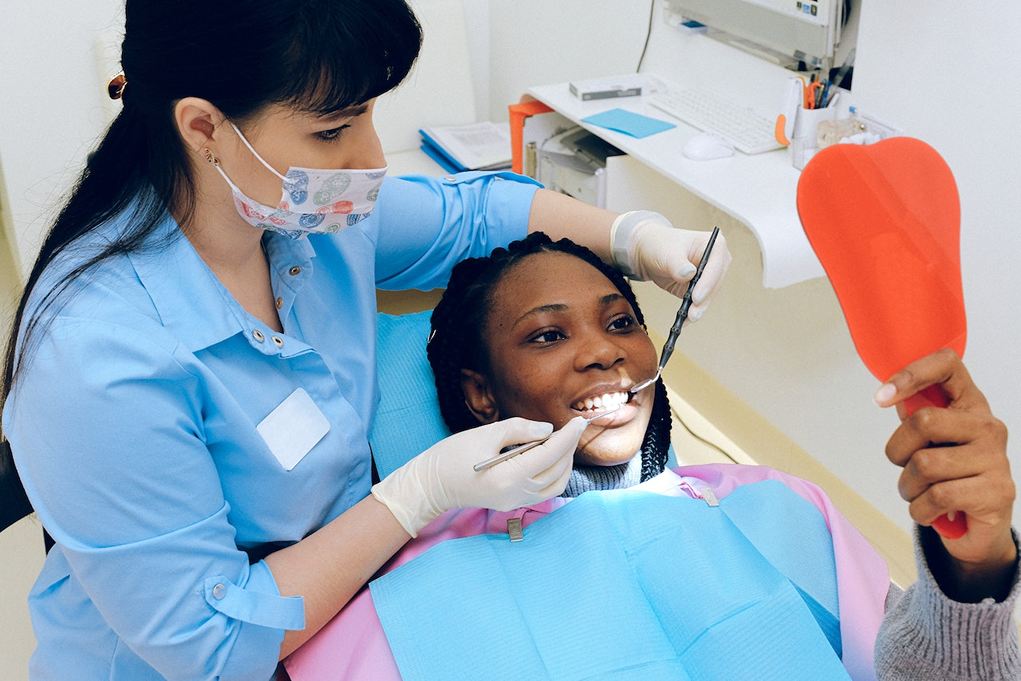A trip to the dentist can sometimes be an event accompanied by anxiety and nervousness, primarily due to the mysteries surrounding various dental procedures. If you’ve ever found yourself wondering about the intricacies of a “root canal” or the exact purpose of “dental crowns”, you’re not alone. Most of us are left perplexed by these dental terminologies.
With the aim of easing this uncertainty and making your next dental visit a more informed one, let’s dive into a comprehensive breakdown of some of the most common dental procedures.

Contents
Demystifying Common Dental Procedures
1. Regular Dental Check-Ups And Thorough Cleanings:
Your first encounter at a dentist’s office is usually a routine check-up, which acts as your primary shield against potential dental issues.
The visit begins with a dental hygienist or dentist meticulously cleaning your teeth. This involves an elaborate process of removing stubborn tartar and plaque, which, if left untreated, can cause numerous dental issues. Following this, your teeth will be polished using a specialized paste. While this procedure is largely pain-free, some might feel minor pressure.
And if you’re looking for an expert tip from a Montclair dentist – remember that consistency is key. Ensure you have a regular check-up scheduled at least biannually. This isn’t just about staving off cavities, but it’s also a preemptive strike against potential gum diseases and other dental issues.
2. Dental Fillings: More Than Just Filling Up:
Dental fillings are quintessential in restoring teeth that have become victims of decay or cavities.
After diagnosing a cavity, the dentist will eliminate the decayed section, clean the area thoroughly, and then fill the cavity. Depending on various factors, fillings can be made from materials like gold, porcelain, silver amalgam, or a composite resin.
The cutting-edge composite resins used nowadays can be tailored to match the natural hue of your teeth, making the fillings almost invisible.
3. The Majesty Of Dental Crowns:
Dental crowns are prosthetic fittings that act as protective coverings for a damaged tooth or an implant.
The procedure begins with the dentist taking an accurate impression of your tooth, which is then sent to a lab. Here, your crown is crafted to perfection. In the interim, a temporary crown might be placed. Once the permanent crown is ready, the dentist ensures it aligns perfectly with your other teeth and fixes it in place.
Did You Know? With proper care, dental crowns can grace your mouth for anywhere from 5 to 15 years, sometimes even longer!
4. Root Canals: Clearing Misconceptions:
Root canals address the treatment of a tooth’s inner sanctum when its pulp becomes inflamed or infected.
After administering a local anesthetic to numb the region, the dentist drills an access point into the tooth, then eliminates the pulp, bacteria, and any signs of decay. The cleaned space is then sealed. Depending on the tooth’s condition, a crown might be added subsequently.
Contrary to popular belief, modern-day root canals, with the advent of advanced techniques and anesthetics, are almost as pain-free as getting a simple filling.
5. The Art Of Tooth Extractions:
There are scenarios where a tooth must be extracted, be it due to severe decay, an underlying infection, or even to address crowding.
The dentist will administer a local anesthetic to ensure no pain is felt. Using specialized tools, the tooth is carefully loosened and extracted. Pressure is felt during the procedure, but it is generally painless.
Post-extraction care is paramount. Abide by the dentist’s instructions, which often include medication, dietary recommendations, and possibly abstaining from habits like smoking.
6. Dental Implants: The Modern Solution:
These are revolutionary tools that replace missing tooth roots, providing a robust foundation for other dental prosthetics.
This is a time-intensive process. Initially, a titanium post is integrated into the bone socket of the missing tooth. As healing progresses, the jawbone embraces the metal post, making it a part of the mouth’s structure. Once this bond is solid, a connector post is fixed atop the implant, and finally, a replacement tooth is secured.
Thanks to their design and integration, dental implants are indistinguishable from natural teeth in both appearance and function.
7. Teeth Whitening: Brighten Your Smile:
One of the most popular cosmetic dental procedures, teeth whitening helps in removing stains and discoloration, offering a significantly brighter smile.
There are multiple methods, ranging from over-the-counter kits to professional in-office treatments. The latter typically use stronger agents and may combine the application with light, heat, or a combination of both to speed up and intensify the whitening process.
While teeth whitening is largely safe, some people might experience tooth sensitivity or gum irritation temporarily. Always consult with your dentist to find a method best suited for you.
8. Dental Bridges: Bridging The Gap:
Bridges, as the name suggests, are used to bridge the gap left by one or more missing teeth. They are anchored either by natural teeth or implants on either side of the gap.
During the procedure, the anchoring teeth are prepared by recontouring them and placing crowns over them. The bridge, which consists of two or more crowns and the missing tooth or teeth, is then cemented onto the anchoring teeth.
Dental bridges not only restore your smile and the ability to chew and speak properly but also help in maintaining the shape of your face.
9. Orthodontic Treatment: Beyond Braces:
Orthodontics deals with correcting teeth and jaws that are out of place. Most people relate orthodontics to braces, but it encompasses more than that.
There are numerous orthodontic solutions, including braces, clear aligners like Invisalign, palatal expanders, and more. The primary goal is to provide the patient with a healthier mouth, a more pleasing appearance, and teeth that are more likely to last a lifetime.
While many undergo orthodontic treatments during their teenage years, there’s no age limit to seeking a perfect smile. Adult orthodontics is becoming increasingly popular.
10. Periodontal Therapy: Protecting The Gums:
Gum health is as crucial as tooth health. Periodontal therapy addresses diseases and conditions that affect the gums and other structures supporting the teeth.
Treatment can range from non-surgical therapies that control bacterial growth to surgical procedures to restore supportive tissues. This might include scaling and root planing, gum graft surgeries, and laser treatments.
Regular dental check-ups and good oral hygiene practices are essential in preventing periodontal diseases. Remember, healthy gums lead to a healthy mouth.
11. Dental Veneers: Crafting Picture-Perfect Smiles:
Dental veneers are thin shells typically made from porcelain or composite resin that are custom-made to cover the front surface of teeth.
Veneers are an excellent remedy for teeth that are stained, chipped, misaligned, or have gaps. The dentist prepares your tooth by removing a small amount of enamel and then bonds the veneer to the tooth’s front surface, transforming its appearance completely.
Apart from their aesthetic advantages, veneers also provide resilience and strength similar to natural tooth enamel. They can be an alternative to more extensive treatments.
12. Dental Bonding: Quick Fixes For Minor Imperfections:
Dental bonding employs a tooth-colored, putty-like resin, which is applied to the tooth and hardened with an ultraviolet or laser light.
This procedure is commonly used to repair decayed, chipped, or cracked teeth; improve the appearance of discolored teeth; close spaces between teeth; and even lengthen a tooth. The entire process usually takes 30 minutes to an hour per tooth.
One of the easiest and least expensive cosmetic dental procedures, bonding can be done in a single visit unless multiple teeth are involved.
13. Dentures: Full Or Partial, Always Functional:
Dentures are removable replacements for missing teeth and surrounding tissues. They can be complete (full) or partial, depending on the requirement.
Full dentures are used when all the teeth are missing, while partial dentures are used when some natural teeth remain. Modern dentures are designed to be comfortable and functional, closely resembling natural teeth and improving the wearer’s smile.
Even if dentures feel a bit strange initially, most people adjust to them quickly. However, regular check-ups are vital to adjust fit and inspect gum health.
14. Dental Sealants: Guarding Against Decay:
Dental sealants are thin protective coatings (made from plastic or other dental materials) that adhere to the chewing surface of the back teeth.
Sealants form a protective shield over the enamel of each tooth, preventing food and bacteria from getting stuck in the grooves and causing cavities. It’s a quick process, with the sealant applied as a liquid and hardened with a special light.
Especially beneficial for children who are just learning oral care, sealants can prevent decay in the molars and premolars for years.
15. Sedation Dentistry: Making Procedures More Relaxed:
Sedation dentistry uses medication to help patients relax and feel more at ease during dental procedures, transforming the way many perceive dental visits.
There are different levels of sedation: from minimal sedation, where you are awake but relaxed, to general anesthesia, where you are completely unconscious. Depending on the procedure and the patient’s anxiety level, the dentist might recommend anything from inhaled nitrous oxide (“laughing gas”) to deeper sedation methods.
Sedation dentistry is a boon, especially for those with dental phobias, allowing them to receive necessary treatments without the associated stress and fear. Proper consultation with a dentist will help decide the right sedation level, ensuring safety and comfort.
In Conclusion
The dental world is evolving, constantly integrating innovative techniques to ensure patient comfort and optimal results. With this comprehensive guide at hand, navigating dental appointments should no longer be an intimidating task.
Embrace the wealth of treatments available, and remember that a smile, nurtured and cared for, is one of the most powerful assets we possess. Always seek the expertise of professionals, and prioritize your dental health to shine with confidence in every facet of life.


